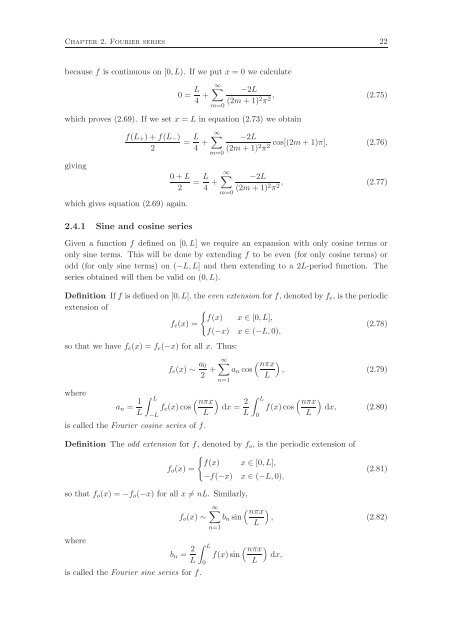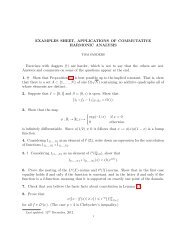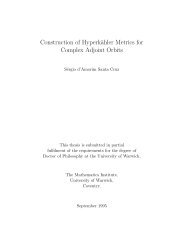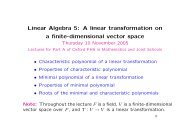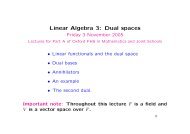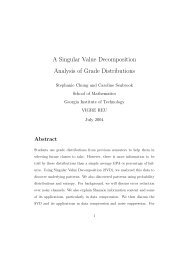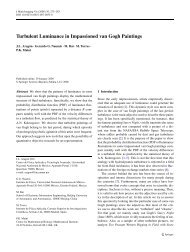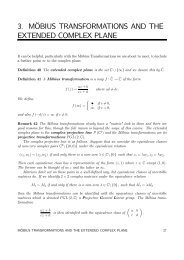Fourier Series and Partial Differential Equations Lecture Notes
Fourier Series and Partial Differential Equations Lecture Notes
Fourier Series and Partial Differential Equations Lecture Notes
Create successful ePaper yourself
Turn your PDF publications into a flip-book with our unique Google optimized e-Paper software.
Chapter 2. <strong>Fourier</strong> series 22<br />
because f is continuous on [0,L). If we put x = 0 we calculate<br />
0 = L<br />
4 +<br />
∞<br />
m=0<br />
−2L<br />
(2m+1) 2 π 2,<br />
which proves (2.69). If we set x = L in equation (2.73) we obtain<br />
giving<br />
f(L+)+f(L−)<br />
2<br />
0+L<br />
2<br />
which gives equation (2.69) again.<br />
2.4.1 Sine <strong>and</strong> cosine series<br />
= L<br />
4 +<br />
∞<br />
m=0<br />
= L<br />
4 +<br />
(2.75)<br />
−2L<br />
(2m+1) 2 cos[(2m+1)π], (2.76)<br />
π2 ∞<br />
m=0<br />
−2L<br />
(2m+1) 2 π 2,<br />
(2.77)<br />
Given a function f defined on [0,L] we require an expansion with only cosine terms or<br />
only sine terms. This will be done by extending f to be even (for only cosine terms) or<br />
odd (for only sine terms) on (−L,L] <strong>and</strong> then extending to a 2L-period function. The<br />
series obtained will then be valid on (0,L).<br />
Definition If f is definedon [0,L], theeven extension for f, denoted by fe, is the periodic<br />
extension of<br />
<br />
f(x) x ∈ [0,L],<br />
fe(x) =<br />
f(−x) x ∈ (−L,0),<br />
(2.78)<br />
so that we have fe(x) = fe(−x) for all x. Thus:<br />
where<br />
an = 1<br />
L<br />
fe(x)cos<br />
L −L<br />
fe(x) ∼ a0<br />
2 +<br />
is called the <strong>Fourier</strong> cosine series of f.<br />
∞ <br />
nπx<br />
<br />
ancos , (2.79)<br />
L<br />
n=1<br />
<br />
nπx<br />
<br />
dx =<br />
L<br />
2<br />
L<br />
L <br />
nπx<br />
<br />
f(x)cos dx, (2.80)<br />
L<br />
Definition The odd extension for f, denoted by fo, is the periodic extension of<br />
<br />
f(x) x ∈ [0,L],<br />
fo(x) =<br />
−f(−x) x ∈ (−L,0),<br />
so that fo(x) = −fo(−x) for all x = nL. Similarly,<br />
where<br />
fo(x) ∼<br />
is called the <strong>Fourier</strong> sine series for f.<br />
0<br />
n=1<br />
0<br />
(2.81)<br />
∞ <br />
nπx<br />
<br />
bnsin , (2.82)<br />
L<br />
bn = 2<br />
L <br />
nπx<br />
<br />
f(x)sin dx,<br />
L L


